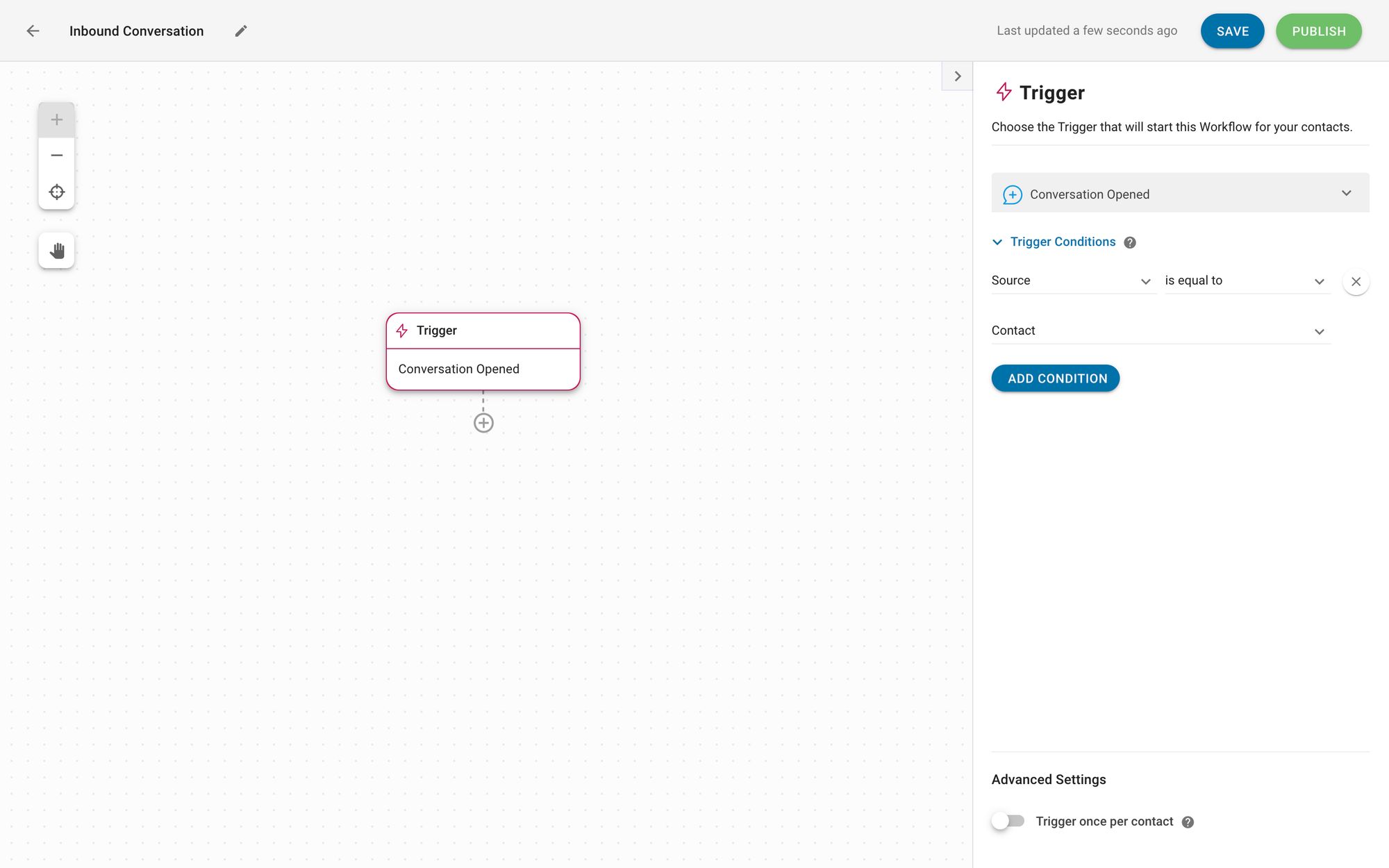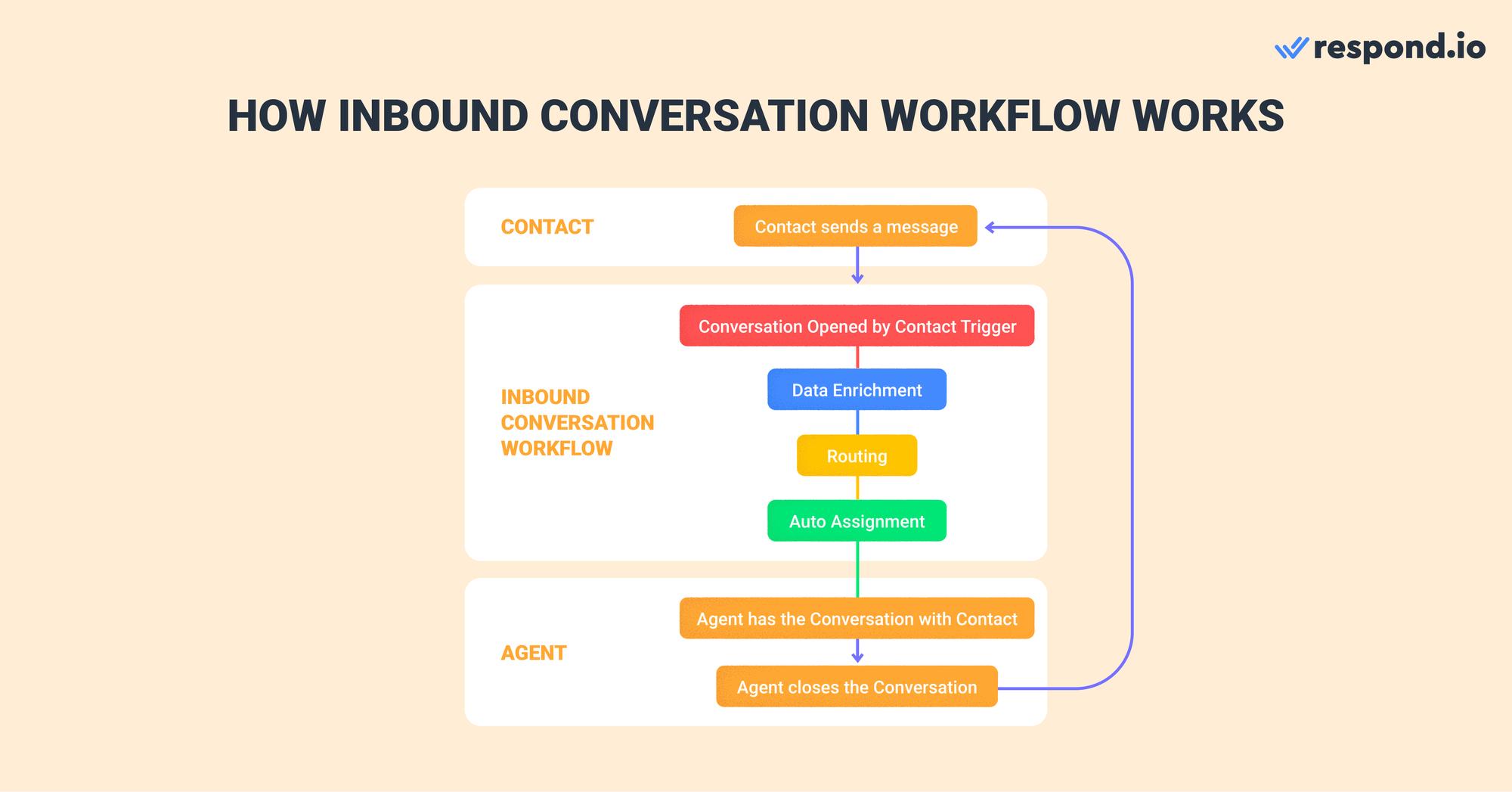

В этом блоге мы проведем вас через основные аспекты входящих разговоров. Мы изучим, почему они важны в стратегии входящего общения, причины, по которым клиенты инициируют разговоры, и как эффективно настроить рабочий процесс входящего разговора с помощью respond.io. Вы также узнаете, как работают эти рабочие процессы и какую функцию выполняет каждый компонент в эффективном управлении входящими сообщениями. Давайте погрузимся!
Основы входящих разговоров
Большинству приложений для обмена сообщениями требуется, чтобы Контакты отправили вам первое сообщение , прежде чем вы сможете с ними пообщаться. Многие ваши бизнес-разговоры по своей сути являются входящими, что означает, что они инициируются клиентами. Есть различные причины, по которым клиенты могут начать разговор с вашим бизнесом.
Почему клиенты начинают входящие разговоры с бизнесом
Чтобы разработать эффективные стратегии общения с клиентами, отвечающие их нуждам, вам нужно сначала понять, почему клиенты начинают разговаривать.

Клиенты могут связаться с Вашим бизнесом по разным причинам. Они могут запросить дополнительную информацию о вашей компании или продукте или совершить такие действия, как покупка или запрос возврата.
Что такое входящая беседа на Respond.io?
На respond.io, разговор означает любое взаимодействие между вашим бизнесом и Контакт с момента открытия чата до его закрытия.

Имейте в виду, что контакт может иметь только одно текущее обсуждение одновременно. Разговор будет открыт только если он отвечает двум критериям - Контакт отправляет сообщение, и Контакт не имеет никакого существующего разговора.
Когда открыт новый диалог, платформа создаст диалог, открытый контактным событием. Это служит триггером для входящего разговора рабочего процесса. Читайте о том, как настроить триггер, используя диалог, открытый контактом.
Как настроить триггер входящего рабочего процесса
Триггеры - это события, инициирующие расширенную автоматизацию под названием Рабочие процессы. Вы можете настроить триггер для входящих диалоговых рабочих процессов в Builder Workflow respond.io. Чтобы получить к нему доступ, перейдите в модуль рабочих процессов. Затем нажмите на Добавить рабочий процесс.

Далее, назовите Рабочий процесс и добавьте необязательное описание. Щелкните на Создание, после чего вы будете перенаправлены на конструктор рабочего процесса.
Теперь вы можете настроить триггер для входящего процесса диалога. В конструкторе рабочего процесса выберите Разговор Открыт как триггер так, чтобы рабочий процесс выполнялся каждый раз, когда открывается диалог.

Далее, установите рабочий процесс на запуск только при входящем разговоре. Для этого просто выберите условие триггера как источник равный Контакту. Теперь, когда вы создали триггер, который запускает рабочий процесс для каждого входящего разговора, давайте исследовать другие части рабочего процесса входящих разговоров.
Превратить разговоры клиентов в рост бизнеса с помощью respond.io. ✨
Управление звонками, чатами и письмами в одном месте!
Обработка входящих диалогов на Respond.io
Рабочие процессы входящих разговоров помогают вам легко справляться с большим объемом входящих сообщений. Здесь вы'узнаете, как рабочий процесс Входящего разговора собирает больше данных о контактах, использует эти данные для маршрутизации диалогов в нужную команду и передает их доступному агенту.
Как работает входящий процесс разговора
Рабочий процесс входящего разговора автоматически обрабатывает Контакты с момента их отправки первым сообщением до тех пор, пока они не будут назначены доступному агенту для продолжения диалога.

Рабочий процесс входящего разговора, как правило, состоит из трех компонентов, которые играют различные роли в обработке входящих сообщений. Вот что вам нужно знать о каждом компоненте:
Обогащение данных заключается в получении данных о контакте или разговоре для определения цели разговора.
Маршрутизация определяет, какая команда будет отвечать за обработку разговора.
Автоматическое назначение означает передачу разговора доступному агенту без участия человека. Вы можете настроить его на основе потребностей и приоритетов конкретной команды.
Рабочий процесс завершается, когда агент назначен контакту, но беседа продолжается на платформе, где агент и контакт общаются в модуле сообщений.
Агенты должны закрыть беседу, как только она будет разрешена, чтобы новый цикл рабочего процесса мог начаться, когда контакт отправляет новое сообщение. Помните, что новый разговор будет открыт только в том случае, если нет существующего разговора.
При создании рабочего процесса "Входящие разговоры" вам нужно выбрать лучшую стратегию автоматического назначения в зависимости от вашего случая использования. Изучите различные способы настройки автоматического назначения для входящих разговоров.
Мастер входящих диалогов с Respond.io
Чтобы получить лучшие результаты бизнеса из входящих разговоров, вам понадобится надежное программное обеспечение для ведения разговоров с клиентами. Как ведущая платформа AI для обмена сообщениями, respond.io имеет все, что вам нужно.
Оснащенный многоканальным почтовым ящиком, response.io позволяет компаниям обрабатывать входящие разговоры по любому каналу обмена сообщениями. И многое другое. Например, используйте разговорный ИИ , чтобы радовать клиентов и экономить ресурсы, или получайте подробную информацию о разговорах в модуле отчетов .
Готовы начать? Попробуйте response.io бесплатно!
Превратить разговоры клиентов в рост бизнеса с помощью respond.io. ✨
Управление звонками, чатами и письмами в одном месте!
Часто задаваемые вопросы и решение проблем.
Почему входящие разговоры важны для бизнеса?
Каждое взаимодействие между предприятиями и клиентами представляет собой шанс добиться измеримых бизнес-результатов. К ним относятся повышение удовлетворенности клиентов, укрепление долгосрочной лояльности, создание благоприятного имиджа бренда и, в конечном итоге, содействие увеличению доходов.
Чем входящий разговор отличается от исходящего?
Входящие разговоры инициируются клиентом, фокусируясь на удовлетворении его потребностей и запросах. В отличие от этого, исходящие разговоры инициируются бизнесом, как правило, для продаж, маркетинга или последующей деятельности клиента.
Какое место входящие разговоры занимают в вашей стратегии входящего маркетинга?
Разговоры являются неотъемлемой частью входящего маркетинга, поскольку они содействуют непосредственному взаимодействию с клиентами. Важнее всего то, что они дают ценное представление о потребностях и предпочтениях клиентов, направляя разработку и стратегию контента.
Дальнейшее чтение
И это все, что вам нужно знать о рабочих процессах Входящих Разговоров. Если вы хотите узнать больше о рабочих потоках, посмотрите эти статьи:






































 Электроника
Электроника Мода и одежда
Мода и одежда Мебель
Мебель Ювелирные изделия и часы
Ювелирные изделия и часы
 Внеурочные занятия
Внеурочные занятия Спорт и фитнес
Спорт и фитнес
 Центр красоты
Центр красоты Стоматологическая клиника
Стоматологическая клиника Медицинская клиника
Медицинская клиника
 Услуги по уборке и няням
Услуги по уборке и няням Фотография и видеосъемка
Фотография и видеосъемка
 Автосалон
Автосалон
 Турагентство и оператор туров
Турагентство и оператор туров




